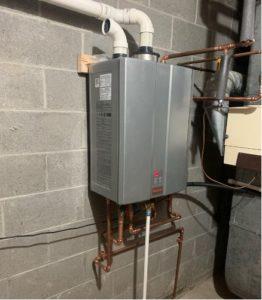Tankless water heaters promise endless hot water. Sounds like an impossible luxury, right? Many of our customers have questions like, is it real? Is there a catch? Is it something to consider? Or is a typical storage water heater the better bet?
Today we’re here to answer all those questions so that you can decide whether a tankless water heater is right for you. Here are a few takeaways up front:
Two things are true at the same time: “endless” hot water is real, and it has its limits.
Here’s the deal: tankless water heaters will never run out of hot water. But they can fail to produce enough hot water if you don’t size them properly. For this reason, the term “on-demand” hot water is more accurate than “endless” hot water. We’ll explain further in this post.
Yes, there’s a catch.
As we just noted, you must size a tankless water heater correctly, or your hot water will not feel endless. Hot water on demand requires getting the “demand” part right for your household. We’ll explain how to do that in this post.
If it’s time to replace your storage water heater, you should consider replacing it with a tankless model.
Tankless water heaters offer advantages in efficiency, convenience, longevity, and value. Any or all of them may make sense for your household. We’ll get into all of them in this post.
Traditional storage water heaters can still serve most homes well.
Just because they’re the traditional way to heat your water doesn’t make them an outdated way to do so. Storage water heaters are reliable and virtually maintenance-free (although they tend to need replacing sooner than tankless models). And storage water heaters work in almost any home, which isn’t always the case with tankless water heaters. We’ll explain this too.
Here’s what we’ll cover:
What is a Tankless Water Heater?
How Does a Tankless Water Heater Work?
Sizing a Tankless Water Heater Properly
Reasons to Choose a Tankless Water Heater
Limitations of Tankless Water Heaters
Let’s dive in!
What is a Tankless Water Heater?
Before you can decide if a tankless water heater is right for you, you should know what it is.
A tankless water heater is a system that draws, heats, and supplies hot water to you only when you need it. This is why tankless water heaters are also known as “on-demand” hot water.
In contrast, a storage water heater is a system that constantly heats and maintains a specific supply of hot water — typically 40, 50, or 75 gallons — in a tank.
As its name suggests, a tankless water heater doesn’t use a tank. It doesn’t keep a supply of hot water at the ready. Instead, it produces hot water only when you turn on a hot-water faucet or start an appliance like your washing machine or dishwasher.
Like storage water heaters, tankless water heaters can run natural gas, propane, or electricity.
Whole-home tankless water heaters are around two feet tall and one foot wide — about the size of a carry-on suitcase. They’re usually mounted on a wall, about three or four feet off the ground. In new construction, they may even be hidden in recessed boxes.
Here’s a Rinnai RU199iN high efficiency gas tankless water heater that we recently installed in the South Hills of Pittsburgh, PA:

As you can see, a tankless unit does look a little like a “tank,” but it’s not holding a reservoir of water. Rather it’s holding the apparatus that heats water as it flows through the unit.
How Does a Tankless Water Heater Work?
Here’s how a tankless water heater transforms cold water into hot water instantaneously, without the use of a tank:
- You demand hot water by turning on a hot water tap — either a faucet or an appliance.
- Cold water enters the tankless water heater via the cold water inlet. This is the pipe that connects your home’s main water line to your tankless unit.
- The water flows through a heat exchanger inside the tankless unit. The heat exchanger is a series of coils that are powered by electricity, natural gas, or propane.
- The heat exchanger instantly heats the water to your desired temperature. The term we use to describe this instant heating process is “flash burning.” A tankless system flash burns the water. (In contrast, a storage water heater warms water more gradually via a constant flame.)
- The hot water flows to its target, like your shower or dishwasher, or washing machine.
- The hot water exits your faucet or valve at the right temperature, ready for you or your appliance to use.
Sizing a Tankless Water Heater Properly
A tankless water heater can be right for you only if it’s the right size for you.
So now that you know what tankless hot water heaters are and how they work, let’s discuss how you choose the right size for your home.
Homeowners are often surprised when we talk about size in relation to tankless water heaters. There’s a misconception that size is relevant only for storage tank models. Not true.
The fact is, an undersized model can’t deliver all the hot water you need, which defeats the whole purpose of tankless and will leave you with a case of buyer’s remorse.
A reputable plumber can and should help you with sizing. But here’s what to know:
Size Means Flow Rate or Gallons Per Minute
In tankless water heater terms, the size of a model is its flow rate. The flow rate for a tankless unit is the amount of hot water it can provide per minute.
Flow rate is measured in gallons per minute (GPM). Broadly speaking, a flow rate of 2-5 GPM works for smaller households, while a flow rate of 6-10 GPM works for larger households.
For any tankless model that you’re considering, its GPM defines its limits. It cannot supply “endless” hot water. It can supply the GPM that it advertises.
But if you size your tankless unit appropriately for your home, you may feel like you have endless hot water. And that’s the goal of going tankless.
Meanwhile, if you choose a tankless water heater with a GPM too low for your household, it will have the same problems delivering hot water to multiple showers or appliances that an undersized storage tank has. This is definitely not the goal of going tankless.
Where You Live Matters
Your geographic region factors into the size of the tankless water heater you need. This is because your tankless unit needs to handle what’s called temperature rise.
Temperature rise is the difference between the temperature of the groundwater coming into your home and the temperature of the hot water you want to use. The greater the difference, the greater the drag on your tankless water heater’s efficiency, and the larger your tankless unit needs to be.
Here in Pittsburgh, the average yearly groundwater temperature is 49°F. And you want your shower to be around 100°-115°F. That means your tankless model must be able to handle a 65° temperature rise.
You Probably Need a Large Tankless Model
With all that said, we rarely recommend the smaller models that supply 2-5 GPM. We find that the large tankless water heaters, which supply 6-10 GPM, are best for most households.
There are two reasons we don’t typically recommend small tankless models:
- Even customers who live in households with a small number of fixtures or people often need hot water in multiple places at once. Some combination of showers, faucets, a dishwasher, and a washing machine running at the same time is common for most of us. And then there are houseguests, which many of us have from time to time. It is a rare household that really is too small for a larger tankless unit.
- For gas-powered water heaters, BTUs (British thermal units) matter too. Small tankless units use around 150k BTUs to heat water. Large tankless units use around 199k. Storage models use much less — only about 35k-65k BTUs. So going from storage to tankless means a huge jump in BTUs, even if you choose a small tankless unit. For not much more in cost, you can go ahead and take the extra BTU hop to a large tankless model.
The good news is, if your demand for hot water does exceed your model’s GPM from time to time, your tankless system will recover quickly — typically in just a few minutes. This is because it does not need to refill and reheat an entire tank full of water, the way a traditional storage water heater does.
But short recovery time aside, if a tankless water heater frequently fails to meet household needs for hot water, it is too small.
Reasons to Choose a Tankless Water Heater
Now that you know what a tankless water heater is, how it works, and how you size one properly, here are the reasons why a tankless water heater may be right for you:
- To reduce your energy bills
While manufacturers have improved the efficiency of traditional storage water heaters in recent years, tankless water heaters are still more energy efficient.
The U.S. Department of Energy estimates that tankless systems are 8% to 34% more energy efficient than storage systems. Your specific energy savings will depend on the type of fuel you use, the amount of hot water you demand, and where you live.
In their exhaustive testing of both tankless and storage water heaters, Consumer Reports showed results that back up the DOE’s claims. They found that, on average:
- A gas tankless model cost $195 per year to run, while a gas storage model cost $245.
- An electric tankless model cost $535 per year to run. while an electric storage model cost $580.
Tankless water heaters save you fuel in another way, too: they eliminate standby heating costs incurred by storage water heaters. Storage models are always using energy to keep the water inside at a constant temperature. This wastes a lot of energy.
For example, over the course of a night, when the demand for hot water is minimal at best, a gas storage heater will warm a tank three or more times to keep its water hot.
A tankless system doesn’t need to do this; it will simply warm your water in the morning when you need it.
The bottom line here: tankless water heaters save you money in fuel costs, whatever type of fuel you’re using.
- To meet the high demand for hot water
The delivery of hot water exactly when and where you need it is a tankless water heater’s main selling point and most compelling feature. And if you live in a large, busy household that uses a lot of hot water, on-demand hot water is that much more attractive.
A whole-home tankless water heater delivers comfort and convenience along with energy savings. You no longer have to dread being the last in line for a shower or worry that your guests will run out of hot water during their stay. Nor do you have to strategically space your laundry loads or wait for the all-clear to run your dishwasher.
You do have to size your tankless water heater correctly, though, as we described in the previous section.
- To save space
Tankless water heaters are smaller and more compact than traditional tank water heaters. To use a furniture analogy, a tankless unit is like an ottoman, while a tank unit is like a chest of drawers.
Also, tankless water heaters don’t take up floor space. They are usually wall-mounted, and they fit in a utility closet or some other tight space. (Not too tight a space, though; tankless water heaters require clearance just like storage water heaters do.)
Ultimately the smaller footprint of tankless models can be the deciding factor in a home where you need to free up square footage or storage space.
Here in Pittsburgh, many older homes have tiny closets and cramped basements. So many Pittsburgh homeowners are thrilled to reclaim some space by replacing their storage water heaters with tankless ones.
- To reduce replacement costs
Tankless water heaters don’t need to be replaced as often as storage water heaters do. Tankless systems can last 20 years or more with proper maintenance. Their manufacturer warranties tend to be for 10-15 years, which reflects their longevity.
Storage tank water heaters have a shorter average lifespan. On average, gas models last around 9-11 years, and electric models last around 10-12 years. Warranties on storage water heaters tend to be less generous at around 6 years.
Further, replacement costs for tankless water heaters are less expensive than those for storage tank models. This is because removing the relatively small tankless units is easier and less time-consuming than draining and hauling away a heavy tank.
- To eliminate safety hazards
Over time, storage water heaters are vulnerable to sediment buildup, corrosion, faulty water pressure, and routine wear and tear. Any of these things can cause a tank to rupture and flood your home.
However, a spontaneous rupture of a hot water tank is extremely rare. A much more common symptom of a worn tank is a water leak that you will likely spot long before a rupture.
With a tankless water heater, flood risk is nonexistent. There is no tank full of water to leak or rupture. When a tankless water heater falls into disrepair, it will stop heating your water, but it will never dump gallons of water into your home.
Note that both tankless and storage water heaters have safety mechanisms that shut down operation if the water pressure exceeds 150 pounds or if the water temperature exceeds 200°F.
6. To increase the value of your home
According to the real estate website Zillow, homes with tankless water heaters sold for 4% more than their expected value. They also sold 43 days faster than expected.
Obviously, selling price and time on the market depend on a host of factors. But as home buyers become savvier about energy efficiency, and more aware of the technological advancements that make homes more comfortable, tankless water heaters can be a major selling point. They are an indicator that a home is up to date.
- Because purchase price is no longer an obstacle
Perhaps surprisingly, the purchase price of a tankless water heater is roughly the same as that of a storage water heater.
This wasn’t always the case. When tankless water heaters first came on the scene around 20 years ago, they were the high-end way to heat your water, and much more expensive than storage models.
But in recent years, the price of storage models has increased dramatically while the price of tankless models has remained more stable.
Today, the average purchase price of storage water heaters ranges from about $600 to $2,500. The average purchase price of tankless water heaters has a narrower range in the upper middle of that: from about $1500 to $2000. Purchase price just isn’t the difference-maker it once was.
Tankless water heaters do offer some pricier models, though. There are specialty units for extra high capacities, precision temperature control, outdoor applications, and alternative fuel sources.
Limitations of Tankless Water Heaters
If you’re deciding whether a tankless water heater is right for you, you want to know the downsides. The convenience of on-demand hot water may overcome all of these, but here they are. A reputable plumber should bring them up with you:
- Higher installation costs
Tankless and storage water heaters have comparable average purchase prices. But installation costs can make tankless water heaters much more expensive upfront.
This is because replacing your storage water heater with a tankless water heater may require the following home upgrades. Many tankless water heater warranties mandate these:
Upgrading your gas line
A storage water heater requires 35k to 65k BTUs to heat water. It can run with a ½-inch gas line.
A tankless water heater, however, requires a whopping 150k to 199k BTUs. It needs a ¾-inch gas line for that kind of heating capacity.
Obviously, this means you may have to replace your gas line with a larger one. Your plumber can determine if this is the case for your home.
Changing your venting system
Many storage water heaters are natural draft tanks. They use a vertical exhaust vent that connects to a chimney or flue to remove combustion byproducts like carbon monoxide. A natural draft venting system requires no electricity. It is made of metal, like stainless steel or aluminum.
Tankless water heaters, on the other hand, use a horizontal vent — either a direct venting system that sends exhaust outside through a wall, or a power venting system that uses a motorized fan to push exhaust outside. Unlike a natural draft vent, a power vent requires electricity and is made of plastic, like PVC or polypropylene.
This means that if you are replacing a natural draft storage water heater with a tankless water heater, you need to overhaul the venting system. You have to go from vertical to horizontal venting; from natural drafting to electric drafting; and from metal to plastic components.
However, some storage water heaters do use power venting, just like tankless models do. If you have a power vent storage water heater, you’re actually well-positioned for a tankless water heater. You already have the electricity exactly where it will be required.
Upgrading your electrical panel
Tankless water heaters require a lot of power to operate. This means they may require a new, dedicated circuit for your home’s electrical panel.
If you plan to install an electric tankless water heater rather than a gas-powered one, it will definitely require a dedicated circuit. It will also require an upgraded power line to your home.
Here’s why: you need at least 125 amps to run an electric tankless water heater. This is a lot of amps.
For reference, storage water heaters require only around 30 amps. And for many homes, the entire electrical panel is only 100 amps. For newer or larger homes, the electrical panel may be 200 amps.
Whether your electrical panel is older at 100 amps or newer at 200 amps, it must serve a whole house full of other appliances. An electric tankless water heater will easily overwhelm its capacity.
For this reason, we rarely recommend electric tankless water heaters. Their power needs put too great a burden on your home’s electrical panel, and the circuit breaker is at risk of tripping all the time.
For example, one of our customers has a five-bathroom home that he wanted to make into an Airbnb. He had an electric storage water heater and figured he should replace it with an electric on-demand water heater to ensure his guests always had hot water. We counseled him to install two 50-gallon electric storage water heaters instead. These two tanks provide plenty of hot water to his guests without overtaxing his electrical panel or requiring massive electrical upgrades.
- Long payback times
If you’re considering buying a higher-end tankless water heater, and if you’ll need various home upgrades to run it, you’re looking at a project that could cost you several thousand dollars.
But with the energy savings that a tankless model provides, you’ll recoup those purchase and installation costs, right?
Well, yes. In 12 to 27½ years, according to Consumer Reports.
In their tankless vs. storage water heater tests, the folks at CR looked at average installation and fuel costs. They found that the payback time for converting from electric storage models to electric tankless models was 12 to 20 years.
The same conversion with gas-powered models had an even longer payback time: 22½ to 27½ years.
Tankless water heaters are certainly more energy efficient. But those energy savings can’t pay you back any time soon.
Note that the payback time is faster if you are building a new home. This is because the gas, venting, and electrical requirements for a new home are simple steps, not complex (and expensive) overhauls.
- Higher Maintenance Costs
Tankless water heaters require regular maintenance. You must have your tankless water heater descaled each year to remove the mineral buildup that reduces its flow rate. Tankless manufacturers often mandate annual descaling in their warranties.
Because of the importance of descaling, some tankless manufacturers have begun including a descaling device with their models. This is a new technology, and while promising, its value and effectiveness are still to be determined.
It’s worth noting that manufacturers recommend (but don’t necessarily require) descaling storage water heaters too. And for storage models, this means draining the tank, which is a large job. Most customers don’t do this, and we don’t encourage it.
Another way that tankless water heaters present a higher maintenance burden: they have a lot more parts than storage water heaters have.
Many of these parts are digital, sensitive, and not routinely stocked by home improvement stores or plumbing suppliers. So when these parts break, the wait time for replacement parts is usually longer than with storage models.
Fortunately, though, tankless water heater technology is solid. Tankless units last a long time. In our experience, they are workhorses that don’t malfunction very often at all.
- Longer wait times for hot water
Yes, you read that right: after you install a tankless water heater, you may find yourself waiting a little longer for hot water to flow from your faucets.
As we explained in a previous blog post on water heaters, a tank-style model heats water consistently throughout the day. This heat radiates, so it travels the pipeline, warming the idle water there. When you turn on the hot water at almost any faucet, it’s already somewhat tepid and needs less time to heat up.
In contrast, a tankless model heats water only when you need it and then shuts off. The idle water in the pipeline stays cold. If you turn on the hot water at a faucet that’s, say, 40 feet of the pipeline away from the tankless unit, that’s 40 feet of very cold water that runs first and continues for a minute or so.
Customers tell us they notice this wait time for hot water.
Tankless models do heat the water quickly, though, so the wait time is never too long — just longer than what you might be used to with a storage water heater.
Tankless manufacturers do offer a solution for longer hot-water wait times: external water pumps that push hot water closer to your fixture.
These pumps have pros and cons. They cost extra, and they make your tankless system operate a bit like a tank that heats the water before you need it. But you can control how often the pump runs, and a pump eliminates the need to run cold water that you won’t use until it’s hot.
- Power outage vulnerability
If you live in an area that loses power often, a storage water heater may be better for you than a tankless water heater.
This is because a tank full of water will remain warm for some time after the power goes out. So if you have a natural draft storage water heater (that is, one that doesn’t use power venting), your home will have hot water even if it doesn’t have electricity.
However, if you have a tankless water heater, any power outage will render your household instantly without hot water until power is restored. Tankless ventilation relies on electricity, even if your model is gas-powered.
Note that storage water heaters with power ventilation won’t work during a power outage either. The water in the tank may indeed be warm, but without electricity, there’s no way to vent the exhaust.
_____________
Considering tankless? Want to compare models and crunch the numbers? We provide free, custom, and detailed estimates. We’ll help you decide if tankless is right for you and walk you through what an installation at your home would require. Give us a call or text us at 412-952-5923. You can also contact us via our website at any time. We look forward to serving you!





